Copyright
©2014 Baishideng Publishing Group Inc.
World J Gastroenterol. Jun 21, 2014; 20(23): 7325-7338
Published online Jun 21, 2014. doi: 10.3748/wjg.v20.i23.7325
Published online Jun 21, 2014. doi: 10.3748/wjg.v20.i23.7325
Figure 2 Current knowledge of autophagy and insulin resistance.
Autophagy and insulin resistance (IR) seem to influence each other reciprocally. On one hand, an increased level of calpain 2 reduces autophagy and increases IR by increasing endoplasmic reticulum (ER) stress. The amount of dysfunctional mitochondria will also increase and contribute to IR. On the other hand, secondary hyperinsulinism due to IR can decrease autophagy if the insulin sensitivity remains present. Furthermore, autophagy can also be suppressed via an IR-mediated reduction in forkhead box class O 1 (FOXO1). Free fatty acids (FFA) can induce IR directly or by increasing ER stress. Correct stereoisomers of diacylglycerol (DG) can induce protein kinase c (PKC) dependent IR. Controversy exists on how autophagy influences the level of FFA and if subsequent correct stereoisomers of DG can be formed. Dysfunctional mitochondria can increase the level of fibroblast growth factor 21 (FGF21), which is able to reduce IR. FGF21 and IR interact with whole body metabolism. Arrows indicate a consequence of a certain alteration, bar headed arrows denote an inhibition. Double-headed arrows present a reciprocal influence. The dashed and double-headed arrow denotes the uncertain relation between FFA and autophagy. 1: ER stress actually increases autophagy; 2: Only right stereoisomers induce PKC. mTOR: Mammalian target of rapamycin; TG: Triglycerides.
- Citation: Kwanten WJ, Martinet W, Michielsen PP, Francque SM. Role of autophagy in the pathophysiology of nonalcoholic fatty liver disease: A controversial issue. World J Gastroenterol 2014; 20(23): 7325-7338
- URL: https://www.wjgnet.com/1007-9327/full/v20/i23/7325.htm
- DOI: https://dx.doi.org/10.3748/wjg.v20.i23.7325









